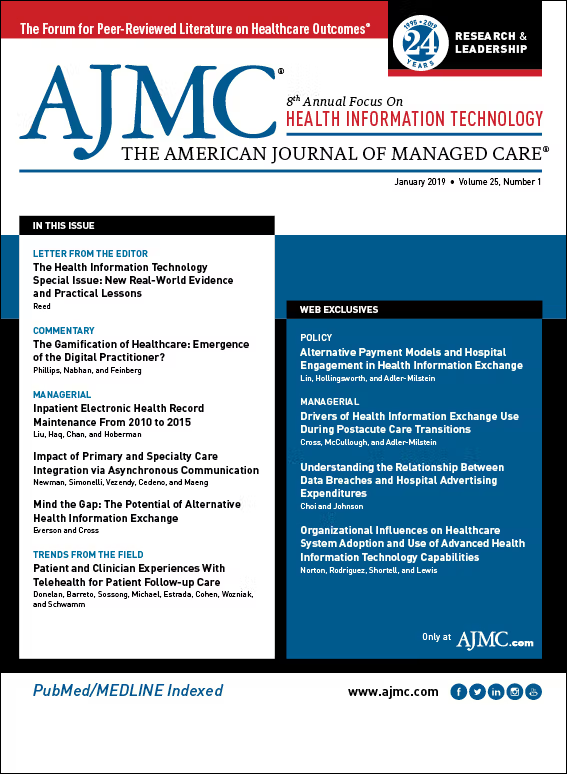- Center on Health Equity & Access
- Clinical
- Health Care Cost
- Health Care Delivery
- Insurance
- Policy
- Technology
- Value-Based Care
The Health Information Technology Special Issue: New Real-World Evidence and Practical Lessons
As technology applications in healthcare continue to grow, electronic health records are maturing, interoperability is developing, and patient-facing technology use is expanding.
Am J Manag Care. 2019;25(1):12Technology use in healthcare continues to grow rapidly, and use cases are ever expanding. As the US healthcare system has largely achieved a major transition to electronic health records (EHRs), this technology foundation supports clinical care and offers rich data for research. Still, we need to more fully realize the potential of technology in improving patient care and outcomes. EHRs are still maturing, interoperability and health information exchange are still developing, and patient-facing technology integration is still growing. The articles in this health information technology (IT) issue of The American Journal of Managed Care® (AJMC®) offer valuable new evidence and lessons from the field in each of these areas within the real-world context of healthcare delivery.
EHRs Maturing
Although the EHR adoption curve has crested, implementation does not represent just a one-time installation or investment, but rather a longer-term process of adapting and improving the technology. In this issue, Liu and colleagues offer a quantitative portrayal of the broad scale of the ongoing clinically informed maintenance activities that are required to use and sustain a mature and up-to-date EHR. As digital technology comes with privacy concerns, Choi and Johnson offer novel real-world evidence on the association between hospital data breaches and advertising expenditures. Further, Norton and colleagues detail the organizational context that facilitates applications of technology beyond simple EHR adoption, including advanced analytics.
Interoperability to Support Care Transitions
For EHRs to fully inform effective and efficient clinical care delivery, data handoffs across transitions in care are essential. In this issue, Newman and colleagues offer a direct example, finding that using a technology tool to directly communicate questions between primary care providers and specialists reduced avoidable health events and the cost of care. When healthcare transitions fall within a given EHR vendor or healthcare delivery system, interoperability is supported by this context; however, Everson and Cross estimate that nearly half of patients have healthcare experiences that extend beyond these proprietary EHR approaches and need external interoperability solutions. The road to full interoperability in the United States is not entirely clear, but Lin and colleagues find that health information exchange happens more deeply within hospitals engaged in alternative payment models. And even when health information exchange capability is in place, Cross et al find that it is underutilized in discharge transitions to skilled nursing facilities and that workflows vary widely.
Patient-Facing Technology
Health IT does not represent an end in and of itself, but it can act as a tool for improving patient-centered healthcare access and patient engagement. As the reach of patient-facing digital health tools expands rapidly, Donelan and colleagues report on high-quality and efficient patient-reported telehealth experiences with patient—physician video visits. Phillips et al discuss growing patient access to direct-to-consumer health apps and the potential to clinically foster this patient engagement to improve patient outcomes.
Conclusions
As technology applications in healthcare continue to grow and mature, this AJMC® health IT issue reflects the range of these forces, emphasizes the practical importance of context and setting, and points to the breadth of exciting health IT opportunities through rich real-world evidence.Mary E. Reed, DrPH, is a research scientist at the Kaiser Permanente Northern California Division of Research and the guest editor-in-chief for the health IT issue of The American Journal of Managed Care®.

Managed Care Reflections: A Q&A With Laurie C. Zephyrin, MD, MPH, MBA
November 12th 2025To mark the 30th anniversary of The American Journal of Managed Care, each issue in 2025 includes a special feature: reflections from a thought leader on what has changed—and what has not—over the past 3 decades and what’s next for managed care. The November issue features a conversation with Laurie C. Zephyrin, MD, MPH, MBA, senior vice president for achieving equitable outcomes at the Commonwealth Fund. This interview has been edited for length and clarity.
Read More
Assessing New York’s Health Care Disparities Using Health Plan Quality Data
November 11th 2025Utilizing the Health Insurance Disparities Index for assessment, the authors found that New York’s Medicaid health maintenance organizations (HMOs) outperformed Medicaid HMOs nationally in addressing health care disparities from 2019 to 2023.
Read More

